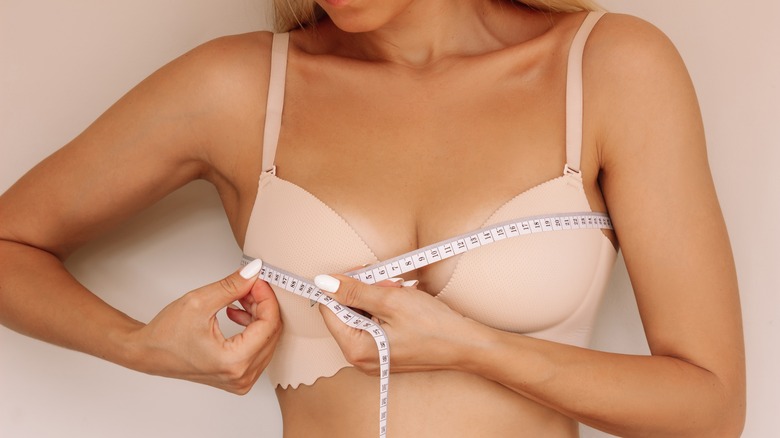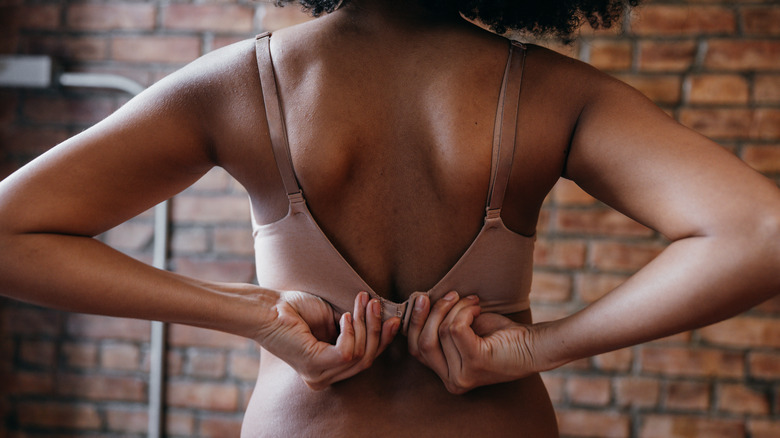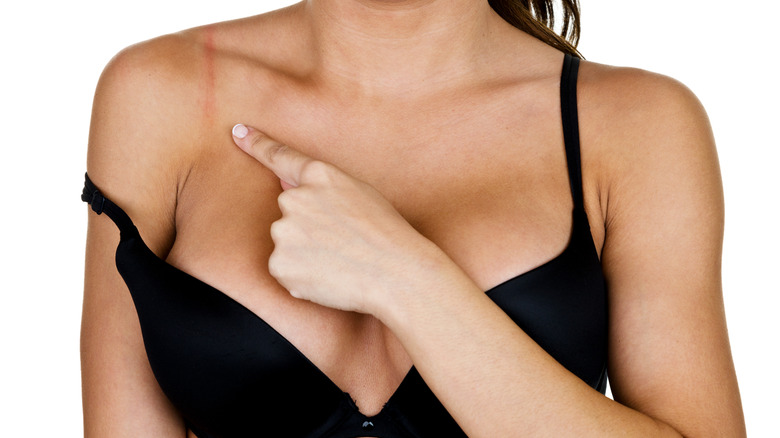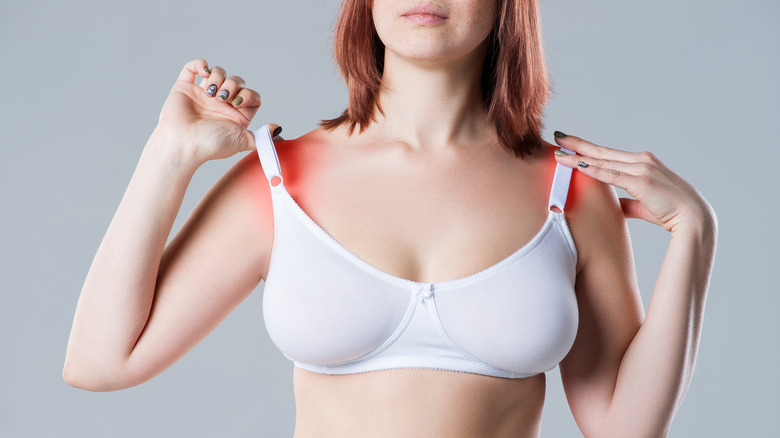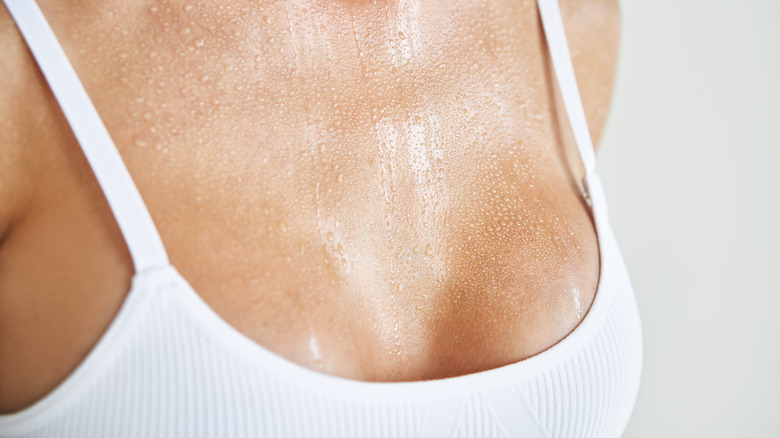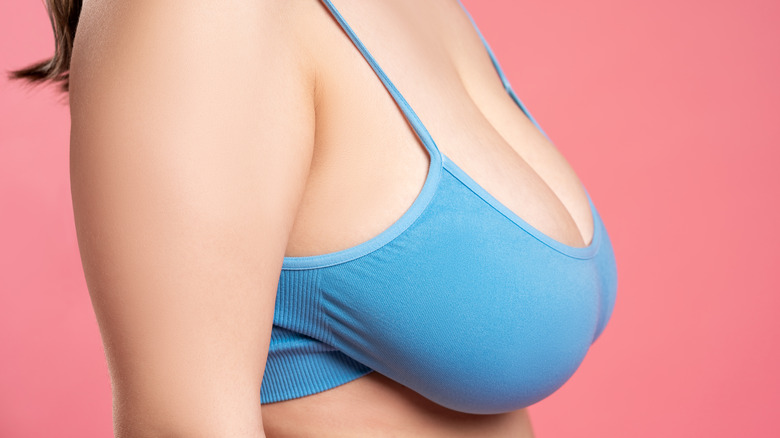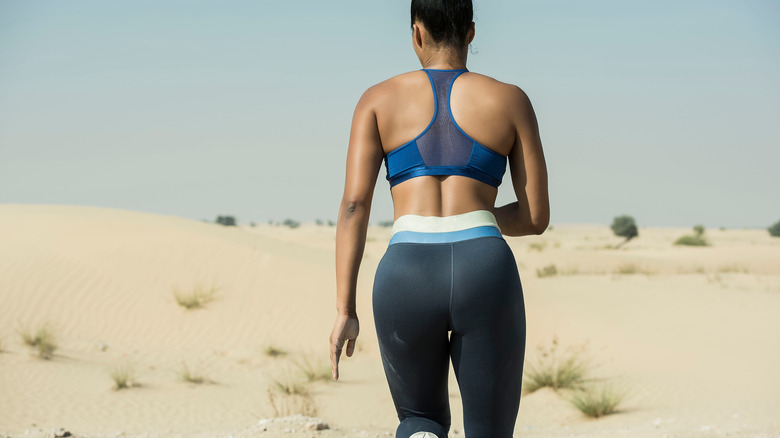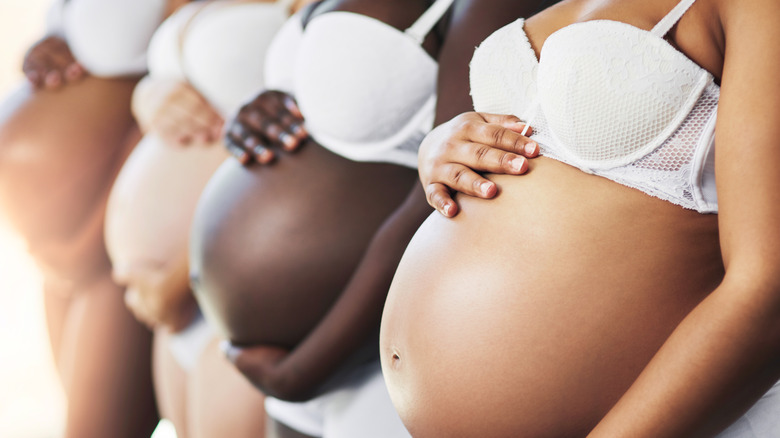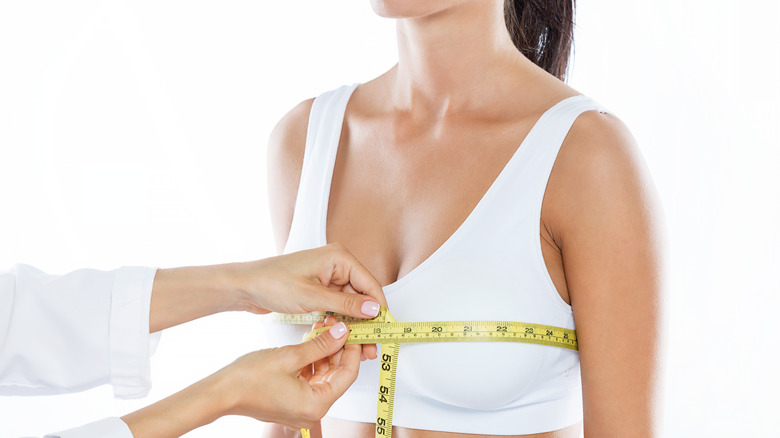The Problems You'll Deal With If You Wear An Ill-Fitting Bra (& It Goes Way Beyond Sagging Breasts)
Bras, those oddly shaped undergarments, are meant to support women's breasts and be comfortable. But those little contraptions can easily become torture devices if the wrong one is worn. A tight bra can squeeze the life out of you — figuratively. And a loose bra leaves your breasts dangling in them, which seriously calls the usefulness of a loose bra to question.
If you're a woman, you probably wear bras or have worn them at some point. Bras represent a rite of passage for many women when their breasts develop. And a lot of women stick with them. So it's surprising that the majority of women go about wearing the wrong bra size. One study published in Chiropractic & Osteopathy reported that about 80% of women wear the wrong bra. Tight bras seem to be a big problem as the researchers noted that most women (70%) wear tight bras while 10% of women wear loose bras.
But are there actual downsides to wearing the wrong bra? And should you care about them? We've outlined the serious effects of wearing the wrong bra size, whether smaller or bigger. And yes, these effects go beyond breast sagging.
Needless discomfort
It can be unsettling to spend the day in a bra that doesn't sit right. A tight bra can make you feel like you can't breathe. And with a loose bra, you might end up raising your shoulders all day just to hold your breasts up by your bra straps. While speaking to Healthline, Robynne Winchester, owner of Bay Area lingerie chain Revelation in Fit, states that an unsupportive and uncomfortable bra often causes shoulder and back pain. This is usually the case when you wear a bra with a loose band or smaller cup size. It's only worse if you add an underwire to the mix. As Winchester notes, if your cup size is small, the underwire will end up pressing on your breasts instead of staying underneath them.
Another issue that comes with an unsupportive bra is breast pain which is known medically as mastalgia. This isn't chest pain but actual pain in your breast tissue. This seems to be a bigger problem for women whose breasts have sagged. This study, published in Scientific Reports, found that having larger or saggy breasts is associated with breast pain. This is likely caused by the weight of the breast stretching the ligament that usually holds the breast up known as the Cooper's ligament. Women usually benefit from wearing a properly fitting and supportive bra to prevent or alleviate this pain, notes the study's authors. The study also found associations between breast pain and tea or coffee consumption, smoking, drinking, and weight gain.
Skin trouble
You have pretty delicate skin around your breasts — and they don't deserve to be assaulted by the wrong bra. There's actually a lot of damage your bra might be doing to your skin. Especially those tight ones. Most of us have noticed outlines or tan marks on releasing the girls from a day long confinement in a tight bra. These dents could come from the straps, the band, or cups. While the less severe marks go away after using a better bra or leaving the girls to breathe, continuous use of a tight bra leads to dark spots, chafing, or bruising as the tight bra irritates your delicate skin. These sure are signs that you need to get rid of the offending bra.
Another skin problem women face from the wrong bra is shoulder grooves. Your bra strap can actually burrow into the muscles on your shoulders and cause a deformity. This happens with years and years of irritation and digging from wearing a bra with a tight, narrow strap. Shoulder grooves are a big risk for women with larger breasts that wear the wrong bra. According to an article published in Aesthetic Plastic Surgery, these grooves can also appear on women with smaller breasts if they form the habit of fastening the straps of loose-fitting bras real tight so as to lift their breasts up.
Poor posture
You most likely know why having a good posture is wonderful. It makes you look good, makes clothes fit better, and places less strain on your muscles and joints. But did you know that those poorly fitting bras in your drawers might be the reason your back isn't ramrod straight?
Following their survey of over 1,000 bra wearers, British underwear company, Pour Moi, developed a prototype of a woman. This woman named "Melanie" spent years wearing an ill-fitting bra. And one of the features Melanie exhibits is hunched shoulders. The perp here is a loose-fitting bra. Ideally, it is the bra band and cups that bear the weight of the breasts. But a loose bra band or cup doesn't support your breasts as well as they should. So, your shoulders end up carrying your breast's weight through your bra straps. Because of the pressure on your shoulders, you may bend them for some relief. Over time, constantly hunching your shoulders can make you develop a hunched back. This can affect the alignment and joints in the spine causing pain in the lower back.
Nerve compression
Developing shoulder grooves are not the only risks of wearing a narrow, tight bra strap, nerve compression is a possibility too. This is one of the causes of the costoclavicular syndrome as described in this 1986 paper, published in Annals of the Rheumatic Diseases.
There is an opening between your collarbone and first rib known as the costoclavicular passage. The costoclavicular syndrome occurs when nerves in this opening get compressed. This condition typically develops among soldiers because they spend a lot of time lugging heavy backpacks. But the costoclavicular syndrome is also seen among middle-aged women with large breasts who have spent years wearing bras with tight and narrow straps.
In both cases the increased weight on the shoulders pulls the collarbone down, narrows the costoclavicular passage, and compresses the nerves there. Hunching of the shoulders due to carrying the weight of the breasts by the bra strap further worsens the compression. The nerve compression leads to pain and stiffness in the neck and shoulders. It causes unusual sensations like the pins and needles feeling in the arm. It also leads to weakness in the arm and puffy blue arms. These symptoms often get worse with activity like exercise or carrying something heavy but better with rest.
Fungal infection
Wearing an ill-fitting bra may increase your risk of getting fungal infections of the skin in your bra area. This is more of a problem if you find yourself sweating excessively in your bra. That excess moisture encourages the growth of fungi, notes the Cleveland Clinic. Fungal infections damage the skin by causing skin irritation or discoloration, rashes, blisters, and cracks which can all be painful.
Speaking to the Cleveland Clinic, Breast health specialist Cassann Blake, MD, notes that it's the positioning of the breast in your bra that accounts for the excessive sweating. "You want to be mindful of how you position your breasts in a bra, particularly during warmer months," she says.
Also, when you wear a larger cup size, it's likely that there would be skin-on-skin rubbing between the skin under your boobs and the skin of your chest. This rubbing can cause excess moisture to build up, notes Dr. Blake, which increases the risk of fungi growing under your boobs. She advises that you position your breasts in such a way that there is no rubbing and use an antiperspirant to avoid sweating especially in summer.
Breast sagging
The dreaded fall! If it's any consolation, it is natural and it will happen to the breasts of every woman with aging — yup all breasts sag. A number of factors come together to produce the sag, notes WebMD. This includes loss of the strength of the breast's skin, the pull of gravity, hormonal changes, weight gain and loss, pregnancy, and menopause. But will your breasts sag if you don't wear the right bra? And what if you don't wear bras? Speaking to the Cleveland Clinic, Breast health specialist, Dr Cassann Blake, clarifies that your choice to wear a bra or not does not prevent or cause breast sagging.
A similar deduction can be made from this study published in BMJ Open Sport & Exercise Medicine. It found that there was some degree of straining to the breast skin of women who participated in the study while they stood, walked, or ran. This strain was highest with running and minimal when standing. But on average, the skin strain was not enough to pose a risk for breast sagging. However, women with larger breasts exhibited higher, potentially damaging breast skin strain especially while running bare-chested. The study also found that using a supportive bra reduced the skin strain which may benefit women with larger breasts especially.
So, women with larger breasts might need to use a properly fitting bra to limit breast skin strain which may cause sagging. Plus, if your breasts have sagged, a good bra will help you lift them up.
Tight sports bras put too much pressure on your breasts
It's always a good idea to wear a sports bra while exercising, especially workouts or sports that have you running or jumping. Sports bras are structured to stop the breasts from swinging in all directions while you work out. They also keep you comfortable during your workout and help prevent breast pain afterwards
But not just any sports bra will do. This study published in the International Journal of Environmental Research and Public Health discovered that sports bras with tighter bands and straps produced more pressure on the skin compared to properly fitting bras. However, the women who participated in the study reported that the tighter sports bras felt comfortable and supportive.
In any case, that increased pressure makes the skin warmer when exercising which contributes to the heat already produced during exercise. All this heat may not easily leave the skin as you exercise. So they remain trapped under the sports bra, especially non-breathable ones. Additional problems produced by a tight sports bra include headaches, neck, and shoulder pain from tight straps.
Wearing the wrong pregnancy or nursing bra may cause mastitis
Your breasts undergo lots of changes during pregnancy and breastfeeding. For one, they change in size and shape. So you need to keep this in mind to get good pregnancy and nursing bras. Pregnancy and breastfeeding bra designer Nikki Clarke, in a blog for Cadenshae advises that you don't merely need a normal bra a few sizes bigger during this time. You need bras without underwires that properly fit during pregnancy and breastfeeding. Ideally these bras should accommodate growing, sensitive breasts, be adjustable yet fully supportive, and be made with a soft fabric. It's a plus if your bras have drop down cups which make nursing easier.
Wearing a bra that is too tight can cause mastitis — a condition many women suffer from when producing milk. Basically, mastitis happens when your milk ducts get blocked and prone to infection. Apart from reducing the risk of mastitis, a supportive bra reduces breast stretch during pregnancy and breastfeeding. This lowers your chances of getting stretch marks or of your breasts sagging badly. A properly fitting bra also distributes the weight of your breasts well, which is good for your posture and prevents body pains.
How to get the right bra fit
Having the right bra might not be top of your concerns. But going about with an ill-fitting bra for years or just a day is too problematic to ignore. You can get your bra fitted by a professional. And ideally, because your breasts keep changing, you should get a bra fitting every six months to a year as advised by Parfait Lingerie. Your bra band size is obtained by measuring the width (in inches) of your chest under your bust. The width of your chest over the largest portion of your breast is also measured and subtracted from your band size to get your cup size.
How you feel and look in a bra is also important when determining if that bra is right for you, advises Bra For Me. Generally, your bra band shouldn't be too tight and it shouldn't slide up. It should be firm yet comfortable and it should carry most of the weight of your breast. Your breasts shouldn't float within your cups or spill out of them. They shouldn't be strangled by an underwire either. Finally, you shouldn't have to pull up your breasts with your shoulders in the right bra. So this means a bra strap that tunnels through your skin is a red flag. But your straps shouldn't be so loose that they fall off your shoulder.
It's also important to trust your judgment. If you feel you're in the wrong, you're probably right. Get fitted, find the right bra — then get a couple more.
